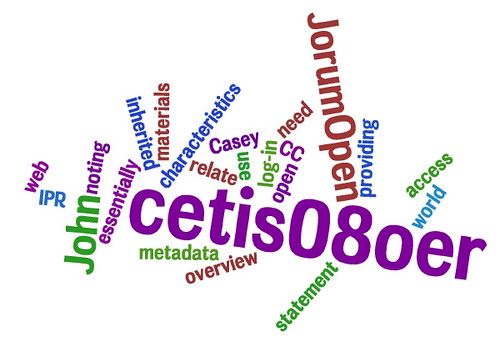The Open Educational Resources session at CETIS08 was a little different from the other conference session in that it aimed to provided participants with some background to the forthcoming JISC / HEFCE OER programme while at the same time giving them an opportunity to comment and provide input. Further information on this call is available from the JISC press release.
(This post summarises the presentations given at this session, Ill cover the discussion in a separate blog post.)
Overview of JISC Open Educational Content Programme
– David Kernohan, JISC
The session opened with a presentation by David outlining the rationale behind this call which is both timely, the OER movement is making real progress worldwide, and opportunistic, the money just happens to be available right now. David also pointed out that HEI business models have changed significantly in recent years as a result of the information explosion. Institutions are no longer the sole repositories of information and knowledge. Information is now ubiquitously availably through multiple channels, not least the Internet. However there is a difference between accessing information and developing learning and understanding and this is where HEIs still have a key role to play.
David acknowledged that there are still considerable barriers to reusing educational content not least of which is IPR. However JISC are not intending to use this call to fund and develop a license structure, rather it is intended to support institutions to develop a process for licensing- whether that be CC or any other type of licence that enables open access to content. Buying licenses is not a sustainable model, changing practice is.
Clearly there is still a risk that institutions and individuals will balk at the idea of “giving away” resources with potential value during a time of recession. However they need to realise that the potential value of new students and enhanced institutional and individual reputation is potentially of greater value than that of the content. This point was neatly illustrated by Patrick McAndrews impromptu presentation which included real evidence of the benefit to the OU of the Hewlett funded Open Learn project.
So while the immediate aim of this call is the online release of existing UK HE learning content licensed for worldwide open use and repurposing the real goal of this programme is to help institutions develop processes and policies that result in sustainable open access to content.
(As this programme is currently at the policy in development stage Davids presentation will not be circulated until the call is released. )
Technical Infrastructure for Open Educational Content
– Amber Thomas, JISC
Next up was Amber who outlined the technical infrastructure approach that JISC are proposing for the OER Programme. Rather than mandating the use of Institutional Repositories and specific licenses, standards and application profiles a more lightweight approach to technical infrastructure is being explored. Content may be released anywhere, in any format, under any appropriately open license however the onus will be on the individual projects to ensure that their content is discoverable, accessible, reusable, attributable, copyright cleared, openly available and supported by stable URIs and a minimum set of tags.
To balance this œanything goes approach there will also be a centralised aggregation of content in JorumOpen. However at this stage it is yet to be decided whether this means all content must be deposited in JorumOpen or linked there. This aggregation of content will enable JISC and HEFCE to showcase the outputs of the programme and will hopefully also provide the potential to build rich services on the aggregated resources
This is a relatively new approach to programme infrastructure and there is still much to be discussed and decided, in particular what constitutes the minimal technical requirements for tagging and persistent identifiers.
The trick here is to balance openness with consistency. The programme will attempt to stitch together an infrastructure based on existing workflows, commonly used tools and the services that can be built around them. Its not just about the content but the role of content in social networks and its not about forcing change but about supporting those that already want to change.
Open Educational Resources “ Opportunities and Challenges for HE
– Li Yuan, CETIS
The final scheduled presentation of the session was from CETIS own Li who presented a summary of her whitepaper Open Educational Resources “ Opportunities and Challenges for Higher Education. Im not going to go into the detail of Lis presentation her as her whitepaper has already been extensively blogged about and her slides area available on the OER session wiki page.
We were also lucky to have two additional and unscheduled presentations from Peter Douglas on the forthcoming JISC commissioned study on business cases for sharing e-learning materials being undertaken by Intrallect and Lou McGill and from Patrick McAndrew on Open University’s OpenLearn project.
Good intentions: improving the evidence base in support of sharing learning materials
– Peter Douglas, Intrallect
This study, which will be reporting shortly, focuses on the business case for sharing e-learning materials, sustainability and levels of openness. The study reports that many projects that started in or around 2002 had very similar aims to the current OER programme but ultimately haven’t been very successful. Understandably it has been difficult to learn why these initiatives failed as institutions are unwilling to publicise their lack of success. Traditionally institutional business models and IPR policies are developed by enterprise/knowledge transfer departments, which are often driven by rather more commercial ideology than academic departments. However it appear that many institutions are currently in the process of transitioning these business models. The impact of this transition remains to be seen.
OU OpenLearn and OLNet
– Patrick McAndrew, Open University
OpenLearn has had considerable impact on the Open University, this is measurable in terms of bringing students into the institution. An estimated 7000 registrations are a direct result of OpenLearn and it is 5th on the list of reasons why people come to the OU. OpenLearn is aimed at primarily at learners rather than other educators, content is the attractor, but the push is for education.
The OU has also set up a range of low-level partnerships based on OpenLearn, this was not a predicted outcome of the project, its a whole new approach to collaboration. Initially the OU found it was surprisingly hard to convince people that Openlearn materials were actually free and somewhat surprisingly there has been little demand for OpenLearn content from the JISC RePRODUCE projects.
OER is about giving permission in advance for things that otherwise have to be negotiated and therefore might never happen. Its about “you act openly, we act openly, let’s collaborate”. However things take time, open collaboration really scales up the time element, its impossible to realistically measure impact over a one year period in any sensible way.
The OU and Carnegie Mellon University have now received additional funding from the Hewlett Foundation for OLNet – a network to support sharing methodologies and evidence on the effectiveness of OERs. This next wave is about impact, evidence and effectiveness.

